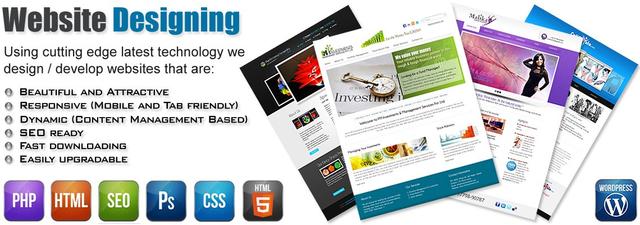A Comprehensive Guide to Responsive Website Design Strategies
Responsive web design has come to be a crucial component in the development of electronic systems, allowing for a smooth user experience across a wide range of gadgets. The landscape of web design is frequently developing, raising inquiries concerning the future of responsiveness and the techniques that will certainly define it.
Comprehending Receptive Web Style
Responsive website design (RWD) is a technique that guarantees a website's format and content adapt effortlessly across a selection of devices and display sizes (Web Design Pretoria). This layout approach is crucial in today's digital landscape, where individuals accessibility sites from mobile phones, tablets, laptop computers, and home computer. RWD boosts customer experience by allowing a web site to preserve performance and looks, despite the tool being made use of
An essential component of RWD includes liquid grids that utilize family member units, such as percentages, instead of repaired units, to specify format components. This versatility makes it possible for photos, text, and other components to resize proportionally, giving an optimal watching experience. Furthermore, media questions are employed to apply different designs based upon gadget attributes like screen size and positioning. This approach makes certain that the website's layout is tailored to the details demands of customers, boosting functionality.
In addition, RWD contributes favorably to seo (SEO) by promoting a single, regular URL for an internet site, which streamlines link sharing and indexing. As mobile phone usage proceeds to rise, recognizing and executing responsive web layout is crucial for businesses aiming to reach a broader audience and enhance general internet performance.
Trick Principles of Responsive Layout
To produce an effective responsive layout, a number of crucial concepts must be taken into consideration. This suggests designing for the tiniest displays first and gradually boosting the format for bigger gadgets.
2nd, adaptable grids and layouts are vital. Utilizing a grid system that adapts to various screen sizes permits an unified distribution of content, making sure readability and usability throughout tools. This adaptability is enhanced by the usage of relative devices, such as ems or percents, instead of fixed pixels.

Lastly, focusing on material pecking order is essential. Clear and logical organization of material improves individual experience, leading visitors through the website perfectly, despite the device made use of. Web Design Pretoria. By adhering to these concepts, developers can produce internet sites that are not only aesthetically appealing yet user-centered and also functional across all tools
Strategies for Fluid Layouts
Fluid formats are crucial for producing flexible web experiences that flawlessly adapt to numerous screen sizes. By making use of percentage-based sizes as opposed to taken care of pixel values, designers can make sure that elements on a webpage resize proportionally, keeping aesthetic harmony across devices. This technique advertises versatility, enabling material to adjust and move as the viewport changes.
One reliable technique for achieving liquid layouts is to use CSS Flexbox or Grid systems. These CSS components allow developers to produce receptive frameworks that can easily reorganize and resize based on the available area. Flexbox masters one-dimensional layouts, while Grid is suitable for two-dimensional arrangements, giving higher control over positioning and placement.
An additional strategy involves utilizing media queries to specify breakpoints where changes are necessary - Web Design Pretoria. By specifying various styles for various display dimensions, developers can change format buildings dynamically, making certain optimal use and aesthetic allure
In addition, integrating loved one systems like ems or rapid eye movements for font dimensions and spacing can even more improve fluidness, as these systems range based upon individual settings or parent aspects. With each other, these methods help with the growth of fluid layouts that promote an engaging individual experience throughout varied devices.
Enhancing Pictures for All Tools
Images play an important function in website design, and enhancing them for numerous tools is crucial for enhancing performance and individual experience. To accomplish this, developers need to use receptive image strategies that make sure photos show appropriately throughout different screen sizes and resolutions.
One effective method is using the HTML" component, which allows for defining several image resources based on the screen conditions. By using 'srcset' characteristics, developers can supply different image resolutions, enabling the web browser to pick the most suitable one for the user's tool.
Additionally, implementing proper documents layouts is crucial. Layouts such as JPEG, PNG, and WebP each serve distinctive purposes and can dramatically influence packing times. WebP, for instance, supplies remarkable compression, bring about smaller documents dimensions without sacrificing high quality.
An additional essential aspect is picture compression. Tools like TinyPNG or ImageOptim can minimize documents dimensions, improving packing speed while maintaining aesthetic integrity. Utilizing CSS for history pictures can enhance packing as they can be controlled much more fluidly throughout devices.
Eventually, maximizing pictures not just boosts site performance yet additionally adds to much better user involvement and retention, making it a This Site fundamental technique in receptive internet design.
Maintaining and testing Responsiveness
Ensuring a smooth customer experience across different devices calls for persistent screening and upkeep of responsiveness. The primary step in this procedure is to use a mix of manual and automated testing tools. Devices such as Google's Mobile-Friendly Examination and BrowserStack allow designers to preview just how their web sites do across several devices and display dimensions successfully.
In addition, it is vital to perform routine audits of your site's format and performance. This consists of checking for breakpoints, making certain elements resize properly, and verifying that navigation remains intuitive. Screening needs to not be restricted to visual elements; capability across different web browsers and tools have to be examined to identify any disparities.

Conclusion
In conclusion, the application of receptive web style strategies is vital for producing adaptable internet sites that enhance user experience throughout diverse tools. By sticking to key concepts such as liquid grids, media questions, and versatile designs, in addition to maximizing pictures and making use of receptive frameworks, developers can accomplish visual allure and boosted loading speeds. Ongoing screening and maintenance additional guarantee that sites stay useful and aesthetically pleasing, ultimately adding to boosted user interaction and satisfaction.
Responsive internet design has actually come to be an important element in the advancement of digital platforms, allowing for a seamless customer experience throughout a plethora of tools.Responsive web layout (RWD) is a strategy that guarantees a web site's design and material navigate to these guys adjust effortlessly across a variety of tools and display sizes. RWD improves individual experience by enabling a website to preserve capability and aesthetics, regardless of the device being used.
Making certain a seamless individual experience throughout different gadgets calls for diligent screening and upkeep of responsiveness.In verdict, the execution of receptive web layout techniques is important for producing versatile internet sites that enhance individual experience across diverse tools.